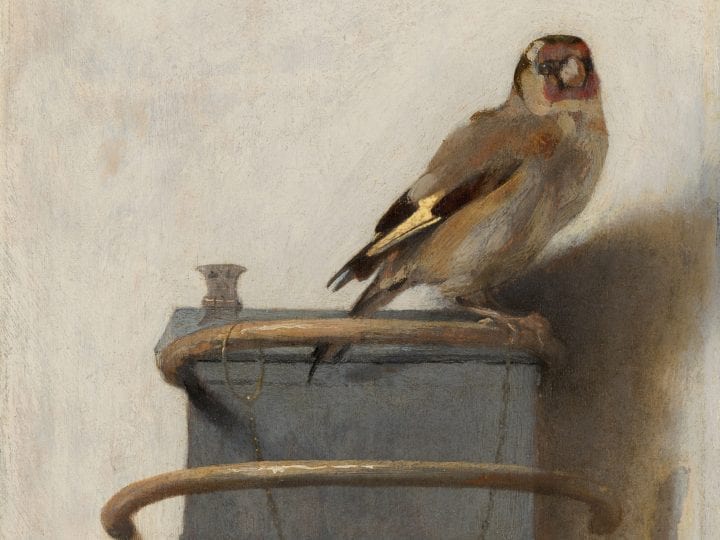This article posits that Carel Fabritius’s illusionistic painting The Goldfinch, 1654, cleverly traded on the experience of a passerby standing on an actual neighborhood street before a household window. In daily discourse, the window functioned as a significant site of neighborhood social exchange and social control, which official neighborhood regulations mandated. I suggest that Fabritius’s panel engaged the window’s prominent role in two possible ways. First, the trompe l’oeil painting may have been affixed to the inner jamb of an actual street-side window, where goldfinches frequently perched in both paintings and in contemporary households. Second, at another point in time, The Goldfinch appears to have functioned as a hinged protective shutter attached to an interior painting of possibly a domestic scene. Together with the encased picture, Fabritius’s panel would have hung on a household wall. In such a capacity, The Goldfinch would have evoked the viewer’s inquisitiveness, as if he or she were a passerby on a neighborhood street before an actual domestic window with an alternatively open and closed shutter.
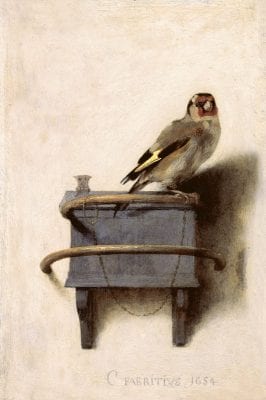
Carel Fabritius’s novel and stunning little painting The Goldfinch (33.5 x 22.8 cm), prominently signed and dated 1654 on the lower right, has been beloved by admirers but has defied interpretive consensus among scholars (fig. 1). The panel presumably had high value in its own time, as indicated by seventeenth-century notarized appraisals of inventories. These make clear that paintings by Fabritius, an esteemed contemporary of Johannes Vermeer in Delft, enjoyed impressive regard.1
Fabritius’s picture depicts a close view of a “deceptively lifelike”2 goldfinch, a popular domestic pet.3 The bird perches beside its characteristic hinged feeding box on one of two semicircular parallel bars to which it is loosely chained. The bars in turn are affixed to a plaster surface. The illusionistic textured brushwork in Fabritius’s painting, which significantly informs my interpretation, reveals the many colors of the goldfinch’s feathers, including characteristic red on his head and a thickly applied, bright yellow streak on his wing. Highlights on the edges of the semicircular rods and on the goldfinch’s feet enhance further the three-dimensional quality of the picture. The bird, the feeding box, and the rods cast a strong shadow to the right on the plaster, which also intensifies the illusionistic effect.
Such trompe l’oeil craftsmanship was extolled by Walter Liedtke, who observed, “it seems characteristic of Fabritius to raise the stakes, going beyond the imitation of solid forms and textures (although they are wonderfully described in The Goldfinch) to suggest the behavior of light and an actual movement—a twitching response—of the bird. In a manner less coy than that of Vermeer’s girl with a pearl earring the goldfinch seems to suddenly turn and look at us.”4
Notably, the viewer returns the goldfinch’s uncanny watch as if from just below the bird and box—a position implied by the painting’s perspective.5 I suggest that the bird’s engagement, and the upward sight line of the viewer’s inferred returned gaze, place the observer illusionistically in a meaningful spatial relationship to the goldfinch. Specifically, I propose that the implied angle of view informs the bird’s slightly elevated location, as if in a window, and seen from the neighborhood street just below.
My analysis of Fabritius’s Goldfinch bases itself on new observations and arguments that are situated within the broader contexts of the window as both a popular seventeenth-century Dutch pictorial motif and an actual physical site of significant neighborhood social exchange. I contend that Fabritius painted the illusion of the goldfinch, its perch, and feeding box against the interior plaster surface of a deep window jamb. As such, the imagery conforms to pictorial convention and actual social practice.
Fabritius’s Goldfinch offers a trompe l’oeil variation on seventeenth-century Dutch genre and still-life paintings, which consistently depicted goldfinches within prominent window-settings. However, he omitted characteristic details of the conventional site, which results in a tight focus and intimate scale. Such changes increase the viewer’s proximity to, and engagement with, the little bird. Fabritius’s novel conception of the illusionistic goldfinch underscores the experimental nature of his imagery.
Subsequent to his 2003 restoration of The Goldfinch, Jørgen Wadum described the various physical modifications and painted additions/changes, which Fabritius (presumably) made to the picture.6 Like the unusual tight focus on the little goldfinch itself, the physical changes to the panel also suggest the experimental or exploratory nature of the painter’s artistic endeavor. Wadum observed that the picture’s unusual thickness (8–10 mm), compared with its small scale, indicates that the panel may have been cut from a larger board. The remnant of a “wooden pin” in Fabritius’s painting indicates that the original plank had consisted of two wooden boards attached with glue and dowels. In the earliest state of The Goldfinch, an approximately two-centimeter-wide black border surrounded the little bird, its feeding box, top perch, and the plaster background. At that point, the unframed painting may or may not have been on display; subsequently Fabritius hammered a gilded frame onto the panel. A greenish line of apparently oxidized copper from such gilding appears under the upper paint layer. X-rays reveal that the frame was attached to the panel with ten nails spaced equidistantly around the perimeter. Since none of the nails extended to the back of the panel, the painting was not affixed to a backing, as scholars have previously proposed.
At a later time, Fabritius removed the gilded frame and extended the white paint of the plaster background to the panel’s right edge. He left visible a narrow band of dark underlayer along the left, top, and bottom edges, retouched his signature, and added the goldfinch’s lower perch. Eventually, white paint was extended to all four edges of the panel, which, according to Ariane van Suchtelen, “seems to suggest that at some time the panel was displayed without a frame.” On the verso of the panel at top center and just below, ten holes, including four for nails, reference two different methods or constructions employed to suspend the painting. Van Suchtelen observed: “remarkably enough, [the methods or constructions were] attached to the panel itself.” In response to the changes in the painted imagery and the panel itself, scholars have proposed various seventeenth-century presentations and functions for The Goldfinch.7
Departing from, and in other respects building upon such analyses, I argue that the painted changes made to Fabritius’s picture and the panel’s varying unframed and framed states were consistent with the bird’s illusory presentation in a window context. I propose two possible variations on such a display of the painting, which I will introduce here and discuss more fully below. First, the panel may have been affixed to the inner jamb of an actual street-side window. With its relatively heightened trompe l’oeil engagement, Fabritius’s painting would have surprised and delighted a viewer/passerby on the neighborhood street and impressed him/her with the artist’s tour-de-force craftsmanship.8
Second, at another point in time, The Goldfinch may have functioned as a protective shutter attached to an interior painting with hinges on one of the two vertical sides of the gilded frame. Fabritius’s panel would have closed over the inner painting and then opened again to reveal the interior picture. As such, The Goldfinch, hinged to the enclosed painting, most likely hung with other pictures on an interior wall of a home, rather than inside an actual window jamb.
Fabritius’s panel as a protective shutter would have engaged the curiosity of the viewer to uncover the inner picture–often a domestic scene–through rotation of The Goldfinch on its hinges to the side. As a result, the panel’s painted front (recto) would face the wall. The oak back of Fabritius’s panel (verso) would face the viewer to the side of the newly revealed interior picture. The plain back of the oak panel would suggest the wooden appearance and position of an actual shutter, opened and adjacent to a window. When Fabritius’s panel/shutter closed anew over the interior painting, the viewer would again encounter the illusionistic goldfinch, perch, and feeding box (recto), as if affixed to the interior of a window jamb, where one would have expected to see the bird. I contend the process would have evoked in the viewer an inquisitiveness similar to that of a passerby on a neighborhood street before an actual domestic window, where an open shutter revealed, and a closed shutter blocked, the real household interior within. The panel’s physical function as a shutter, on the one hand, and its illusionistic painted imagery, on the other, engaged the Dutch window in independent but complementary ways.
Windows and the Neighborhood
In the seventeenth-century Northern Netherlands, the window was both a popular pictorial motif and an actual neighborhood site of significant social exchange. Many mid-seventeenth-century Dutch paintings with close outdoor views of illusionistic open windows or window-niches–with or without goldfinches–manifest the considerable appeal of the window as a prominent pictorial feature.9
Mid-seventeenth-century perspective boxes, such as Samuel van Hoogstraten’s A Peepshow with Views of the Interior of a Dutch House, 1655–60 (fig. 2), exemplify further the contemporary interest in illusionistic views into a domestic interior.10 The gaze into a perspective box requires a small peephole, which affords a view akin to that of an open window, so that the optical illusion of interior, three-dimensional space materializes. Fabritius’s A View of Delft, with a Musical Instrument Seller’s Stall, 1652, a scene painted presumably for the interior of a perspective box,11 manifests his own strong interest in such illusionistic craftsmanship (fig. 3). Mid-seventeenth-century Dutch writers on art as well as wealthy collectors held in high esteem both the paintings of open windows/window-niches and the perspective boxes.12 The Goldfinch ’s illusory engagement of the window may be understood in the context of such mid-century tour-de-force artistry.
In addition to its appeal as a pictorial motif, the window played a significant role in daily neighborhood discourse. Open windows afforded opportunities for the casual social exchange integral to seventeenth-century Dutch neighborhoods, which occupied the liminal space between home and city, while intersecting them both. The physical constituent parts of a neighborhood included only one or two streets—or part of one side of a canal or of a long street—all with their adjacent alleys.13 Neighborhoods, each with its own colorful name,14 required all residents regardless of socioeconomic position, religion, profession or trade, nationality, citizenship, or immigration status to belong to their respective long-standing neighborhood organizations (gebuyrten).15 Through numerous neighborhood regulations (buurtbrieven), such communities sought the shared goals of friendship, brotherhood, and unity, as well as individual and communal honor.16
Neighbors had an obligation to stay aware of daily events and gossip because the neighborhood’s honor depended upon the unsullied reputation of its individual residents.17 To such ends, neighborhood regulations wielded what historians and sociologists call “social control” over many aspects of the lives of residents—male and female.18 Besides being a physical place, a neighborhood constituted “a social network” and “safety net,” which were contingent upon reciprocity and a community of solidarity.19
Administrators elected by residents oversaw gebuyrten meetings, upheld order and quiet, mediated among neighbors, and enforced the binding regulations, which did not warrant the intervention of civic authorities.20 Neighborhoods had as important a function as other social networks, such as family, church, guilds, civic guards, and so on.21 However, the larger districts determined by the city for the organization of the civic guards, fire fighting, and tax assessment lacked the inclusiveness and social fluidity offered to all, including women and immigrants, which characterized neighborhoods.22
Buurtbrieven repeatedly addressed the goals of friendship, brotherhood, and unity that verbal and nonverbal neighborhood communication could foster, as well as the all-too-often negative consequences that neighborhood interactions could foment. Given the multitude of neighborhood residents of various geographical origins, religious persuasions, professional training, social aspirations, and idiosyncratic peccadillos, conversation and gossip invigorated friendships. But they also spurred antagonisms through accusations, and the subsequent alignments created among those sympathetic to one side or another. Virtually all residents—rich, middle-class, and the less fortunate—were vulnerable at any given time to another’s scrutiny.23
Colorful evidence of typical sixteenth- and seventeenth-century verbal exchanges and gossip generated in Dutch neighborhoods can be found in numerous gebuyrten petitions and legal documents.24 These repeatedly reference both the positive outcomes and unfortunate consequences of neighbors’ serious and frivolous actions and interactions, shared celebrations, use of innuendo, and fights and complaints about a myriad of perceived offenses. Residents witnessed, espied, or learned through gossip about such actions. Petitions and legal documents also repeatedly attest to the influence of neighbors’ accounts and their testimonials regarding the character of protagonists and antagonists.
Due to the extremely crowded conditions in seventeenth-century Dutch cities, one did not have to look far or strain hard to eavesdrop on neighbors’ news, their conflicts, or their deviations from gebuyrten regulations. Open windows, in particular, facilitated and invited gossip, glimpses, and glances that passed easily between home and street. They offered a significant opportunity to collect and gauge all kinds of news—from the petty to the scandalous.
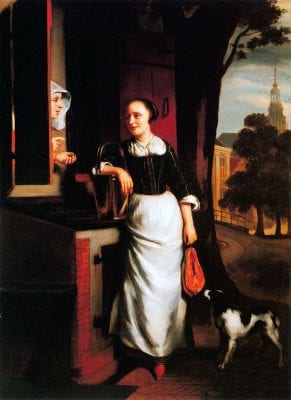
Seventeenth-century writers commented on such access, which open windows made available. In his exposition on Dutch architecture, which was probably written between 1594 and 1605, Simon Stevin (1548–1620), a Flemish engineer who had lived in Holland since 1581, remarked that “[illuminated places in front of the houses facing the street] are good for a man who does not want his wife or daughters to sit on display in the windows and be visited by those who pass by along the street.”25In his perspective box, Samuel van Hoogstraten depicts just such a young woman in a domestic interior seated by a window through which a male passerby on the street peers in at her (see fig. 2). In Nicolaes Maes’s The Maidservant, ca. 1659, a woman leans out of an open window and chats with a female neighbor on the street (fig. 4).
The Dutch moralist Jacob Cats (1577–1660) also remarked on the common practice of women who position themselves at street-facing domestic windows and admonished that they should not dally or be idle beside a window or an open doorway.26 Clearly the popular practice of perusal and gossip at open windows did not abate. In 1720, a resident of Medemblik in northern Holland observed that the neighbors “these days are always at their doors and windows,” and it was difficult not to encounter each other.27 Such pronouncements attest to the actual widespread practice of those who peered out open windows at passersby on the neighborhood street and, in turn, passersby who peered into domestic windows—a practice upon which neighborhood social control depended.
Past Scholarship
Previous interpretive studies of the artistic craftsmanship and subject matter of The Goldfinch have reached varied conclusions, but they have not recognized the little bird’s conventional placement within a window setting. Some studies, for example, liken the painting’s illusionism and subject to that of a few Dutch paintings that depict dead or nondescript live birds.28 In the cited comparative pictures, however, the pictorial and physical contexts, and the engagement of the viewer, differ significantly from that of The Goldfinch.
Other scholars have compared the possible meaning of the goldfinch on Fabritius’s little panel to that of seventeenth-century Dutch paintings of any type of bird and/or their cages, which they have interpreted in a range of moralizing ways. Seventeenth-century Dutch images of birdcages have been understood as symbols of domesticity.29 Depictions of closed birdcages have been likened to virtuous women busy in their homes rather than engaged in inappropriate activities, including spreading gossip in the neighborhood.30 Some scholars have concluded that images of a tethered tame or trained bird offer a “pedagogical metaphor.”31 Depictions of a bird, especially a partridge,32 out of its cage have been understood as a symbol of uncontrolled love or loss of virginity. Pictures of a man’s offer of a bird to a woman33 have been interpreted as a metaphor for licentiousness because the gesture plays on the word “birding” (vogelen) in Dutch, which connotes sexual activity.34 The Goldfinch, however, lacks any pictorial or contextual elements that would liken it to such pictures, which scholars have argued embody various moralizing meanings.
Other studies have provided more focused analyses of Fabritius’s goldfinch as a specific species. M. M. Tóth-Ubbens’s examination of The Goldfinch, for example, contextualized the depiction of the bird, in part, through reference to ornithological scholarship.35 The iconography of The Goldfinch has also been cited in a study of European devotional imagery.36 In addition, the little bird on Fabritius’s panel has been likened to emblematic images of the goldfinch, which celebrate the bird’s ingenuity and adroitness in learning to pull on a cord to access water or food.37
Such comparisons of Fabritius’s Goldfinch to other depictions of an unidentifiable bird, a birdcage, or a goldfinch, in particular, do not do justice to the novelty, experimentation, and illusionism inherent in the little painting, which exemplifies the kind of unusual artistic achievement for which the artist has been praised. Although Walter Liedtke speculated in only general terms that the painting might have been part of “a construction physically (if not conceptually) similar to a design of a perspective box” or some other “ensemble,” he extolled Fabritius’s exceptional achievement. Liedtke concluded: “Like Vermeer, Fabritius had a knack for seeming to do what had never been done before (as scholars have noted) by doing several things that had been done before all at once.”38
Goldfinches in Windows: Paintings and Social Practice
Mid-seventeenth-century Dutch paintings of a goldfinch, its characteristic house/cage, perch, and feeding box, or some combination of these, include window/window-niche genre scenes by the Leiden artist Gerrit Dou; his Leiden follower Domenicus van Tol; and Dou’s pupil Matthijs Naiveu, who worked in Leiden and Amsterdam (fig. 5-8).39 They also include still lifes with goldfinches perched within a window surround by the German artist Abraham Mignon, who painted in Utrecht in 1664 (fig. 9). Unlike the still-life paintings, the window/window-niche genre paintings typically include the goldfinch’s characteristic step- or scroll-gable house,40 which contrasts with depictions of simple wooden or metal birdcages for indeterminate species. The design of the goldfinch’s house/cage derived from a style of domestic architecture built in the Northern Netherlands in the second half of the sixteenth century.41
All of the genre paintings with goldfinches depict a frontal view of an open window/window-niche, as if seen from a neighborhood street.42 In Dou’s Young Girl at the Window, 1662 (fig. 5), the chained goldfinch stands on its perch, beside its feeding box and little house/cage. A vertical board affixed to an outdoor wall and set flush against the frame of the open window supports them. In the other examples of such genre pictures, the goldfinch’s house/cage, perch, and feeding box appear in three-quarter or profile view within the window jamb. Examples of such pictures include Dou’s A Girl with a Basket of Fruit at a Window, 1657 (fig. 6; see right jamb) and Woman at a Window with a Copper Bowl of Apples and a Cock Pheasant, 1663 (fig. 7; see left jamb); and Matthijs Naiveu’s Boy and Girl Blowing Soap Bubbles, ca. 1700 (fig. 8; see upper-left jamb), painted when the artist worked in Amsterdam.43
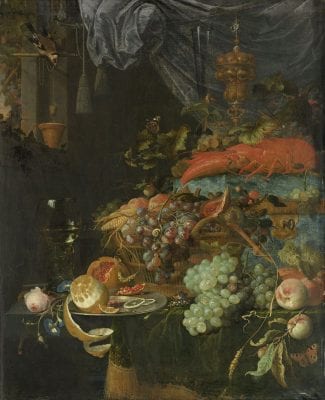
The still-life paintings by Abraham Mignon that depict a goldfinch in a window surround, such as Still Life with Fruit and a Goldfinch, 1660–79 (fig. 9), provide a close, slightly upward angled sight line originating from within a domestic interior.44 The plaster surface of the interior of the window jamb in Mignon’s painting supports the bird’s perch and feeding box without the characteristic house/cage seen in the genre paintings with goldfinches. The almost frontal angle of the little bird, perch, and feeding box in Mignon’s painting approximates that seen in Fabritius’s Goldfinch.
Seventeenth-century documentary sources confirm that these depictions conform to the reality of how such birds were displayed. An actual pet goldfinch and its cage traditionally occupied the domestic front room (voorhuis), which faced the street. In his travel journal from 1640, Peter Mundy reported that the Dutch voorhuis housed “Costly Fine cages with birds”: “Furniture and Ornaments off their dwellings very Costly and Curious, Full off pleasure and home contentment, as Ritche Cupboards, Cabinetts, etts., Imagery, porcelaine, Costly Fine cages with birds, etts.; all these commonly in any house of indifferent quality.”45 The 1662 description of the estate of Johan Chrisosthomus de Backer in a sale in The Hague listed among his many possessions in the voorhuis “six birdcages, a goldfinch’s cage among them.”46 The Hague document that describes a goldfinch’s cage in a voorhuis and the Leiden, Amsterdam, and Utrecht artists who depicted goldfinches in voorhuis windows attest to the geographically widespread adoption of the bird’s characteristic display.
In paintings, the position of the goldfinch within a window jamb contrasts significantly with seventeenth-century Dutch depictions of unidentifiable birds. They appear in plain wooden or metal cages and in a range of household locations. Simple wooden birdcages sometimes hang just inside the jamb of an open window/window-niche in paintings with either an outdoor or an indoor point of view, as in Dou’s Woman at a Window with a Copper Bowl of Apples and a Cock Pheasant, 1663 (see fig. 7). However, they also sometimes hang on an interior wall47 or are attached to an interior column.48 Metal birdcages hang from the ceiling in some paintings of domestic interiors, such as in Dou’s Lady at Her Toilet, 1667 (see fig. 15). Such diverse placement of unidentifiable birdcages in seventeenth-century Dutch paintings throws into even higher relief the conventional display of the goldfinch.
Fabritius’ Illusionistic Goldfinch within a Window Jamb
Akin to Dutch paintings that include a goldfinch, Fabritius’s illusory imagery also situates his little bird inside a deep window jamb. I further suggest that the oak panel itself in an unframed state (before the addition of the gilded frame or after its removal) may have been affixed to the inside of an actual window jamb. In such a display, The Goldfinch’s final and unframed state—in which the painted background extends to all four edges of the panel49—would have created the most persuasive illusion of continuous space between the painted plaster within the picture and the plaster surface of the actual window jamb.
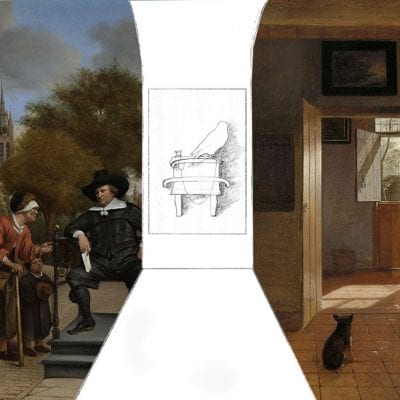
Fabritius offers a close frontal view of the goldfinch as if seen, I argue, from within a window surround. In order to illustrate the little bird’s illusionistically implied site within the painting, as well as the physical location of the panel itself within an actual window, I superimposed the composition of Fabritius’s painting on the inside surface of a sketched window jamb (fig. 10). Details of a characteristic neighborhood street and a domestic interior flank the hypothetical window jamb. I adapted those details from paintings by Jan Steen and Pieter de Hooch, but only for illustrative purposes.
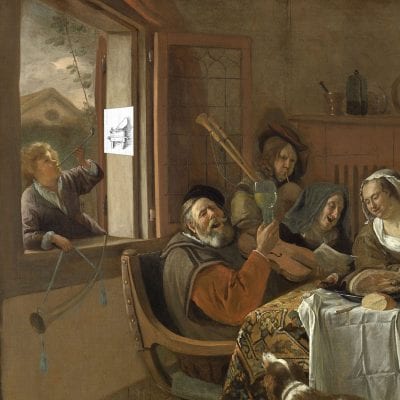
My second mock-up provides another example of the sort of deep plaster window jamb in which I contend Fabritius illusionistically situated his goldfinch, perch, and feeding box in the painting itself.50 The mock-up also shows the possible display of the actual painting within a real window jamb (fig. 11). I superimposed the painting’s composition on the interior surface of a window jamb in a detail from a second Jan Steen painting. Unlike figure 10, however, figure 11 lacks the frontal, close view of Fabritius’s little bird. In the detail from Steen’s painting in figure 11, the young boy, who leans in at a window from the street, references well the easy social exchange afforded neighbors and residents through open domestic windows where pet goldfinches were conventionally displayed.
In particular, I propose that the implied plaster surface of a window’s deep left jamb supports the perch of Fabritius’s little bird. The strong contrast of bright light on the left side of the painting and the dark shadow cast on the right characterizes well the natural light/shadow interplay on the interior surface of an actual left jamb, perpendicular to a window front (see fig. 1, fig. 10–11). The illuminated plaster on the left of Fabritius’s painting describes that part of a left jamb, which would be closest to the bright natural light source and the street. The deep shadow cast on the right by the goldfinch, perch, and feeding box describes the innermost part of a left jamb, which would be closest to the relatively dimly lit domestic interior.
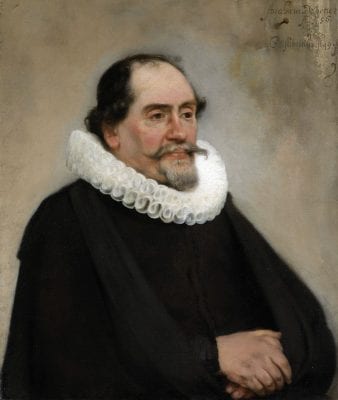
Fabritius’s illusionistic painting signals the site of a plaster window jamb in still additional ways. I suggest that the artist’s signature and the picture’s date in gray paint,51 inscribed on the background plaster, simulate the type of short inscriptions, notably sometimes in (gray) pencil, which one actually encountered on outdoor seventeenth-century Dutch surfaces. Such locations included windows, significantly, as well as walls, houses, doors, and so on. I contend that the artist’s similarly inscribed gray signature and date on an outdoor plaster wall in the background of other of his paintings, which predate The Goldfinch, underscore his earlier purposeful and witty simulation of this cultural practice. Those pictures include Self-Portrait, ca. 1647–48,52 Portrait of Abraham de Potter (1592–1650), Amsterdam Silk Merchant, 1649 (fig. 12)53 and A View of Delft, with a Musical Instrument Seller’s Stall, 1652 (see fig. 3). With his signature, Fabritius identifies himself as the artist of the painting and simultaneously contributes to the imagery’s impressive trompe l’oeil quality. He cleverly blurs the line between his identity as the creator of the picture and an illusory identity as passerby who has written graffiti on the plaster wall below the little bird.
The widespread popularity of such casual writing on windows and other outdoor surfaces can be illuminated by numerous relevant examples published in 1682 (and later reprinted) in a book by Jeroen Jeroense (a pseudonym for Hieronymus Sweerts, 1627–1696) entitled Koddige en ernstige opschriften, op luyffens, wagens, glazen, uithangborden, en andere taferelen. van langerhand by een gezamelt en uytgeschreven door een liefhebber derzelve (Comical and Serious Inscriptions on Awnings, Carts, Windows, Signboards, and Other Boards. Gradually collected and written down by a lover of the same).54 In a notebook, the author recorded graffiti seen in several Dutch cities on an array of outdoor surfaces. The inscriptions range from respectable short posts to biting comments and jokes.
Many of the physical locations of the written words transcribed by Sweerts closely approximate the implied plaster window-jamb in Fabritius’s painting with his signature and date. Sweerts mentioned numerous instances of writing on windows, such as “on a leather buyer’s window”55 and “in the Hague on a window on Geest Street.”56 In some examples of inscriptions on windows he specified the location as that of a house: “in Deventer at the house of a cooper”57 and “in the house of a legal scholar.”58 Sweerts also noted writing “against the wall of a house,”59 “inscription in front of a house,”60 and “a neighbor wrote beside his door.”61 Significantly, Sweerts also commented that some of the inscriptions had been written in pencil, which, I argue, the gray color of Fabritius’s signature and date on the plaster surface in his painting simulates. Sweerts recorded, for example, “written on a wall with pencil”62 and “on the wall of ‘The Role’ written with a pencil.”63
Often Sweerts identified the profession of a particular house’s occupant and the city in which such inscriptions appeared. Such information reveals the broad socioeconomic spectrum of the households and the widespread cultural familiarity with such writing. The inscribed gray letters and numbers on the plaster in The Goldfinch could have reminded a viewer of the casual writing and markings on windows, doors, and walls of houses occupied by a range of middle-class artisans and tradesmen. Sweerts provided numerous examples: “in front of a bird seller’s house”;64 “notified on a baker’s door”;65 “in front of the house of a grain merchant”;66 “in front of a tobacco seller’s door”;67 “on the wall next to a fireworks maker”;68 and “above the door where a cupper lived.”69
Many of the comments recorded by Sweerts appeared on sites in Fabritius’s hometown of Delft, which attests to the artist’s certain familiarity with the custom. Sweerts observed writing, for example, on a window “in Delft in the Red Mill, by the Hague’s Gate”;70 “in front of a painter’s house in Delft”;71 “in front of a house in Delft, on the market”;72 “in front of a tobacco-seller’s shop in Delft”;73 and “pasted in front of a grocer’s door in Delft.”74
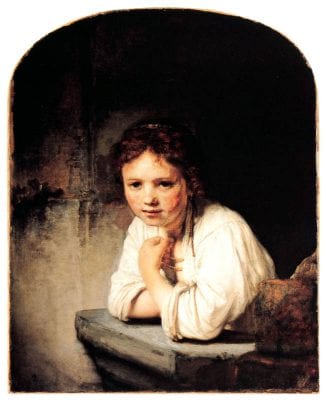
Pre-dating Fabritius’s Goldfinch by nine years, Rembrandt’s painting Girl at a Window of 1645 provides a revealing precedent for the placement of a trompe l’oeil painting in an actual window to fool passersby on a neighborhood street (fig. 13). Rembrandt may have introduced Fabritius to the idea of a window as a trompe l’oeil setting when, between 1641 and 1643, the younger artist lived in Amsterdam and purportedly studied with the master.75 Both artists chose subjects for their trompe l’oeil paintings—a half-length girl and a goldfinch—that passersby typically would have seen at an actual domestic window. The success of the illusion in the two paintings depended both on their subjects, which were appropriate for a window setting, and the imagery’s trompe l’oeil effects.76
In his 1708 Coeurs de Peinture,77 Roger De Piles (1635-1709), a French art theorist and painter who owned Rembrandt’s Girl at a Window,78 recounted the story of the painter’s trompe l’oeil ruse, which has relevance for my interpretation of The Goldfinch.
On one day … Rembrandt amused himself by painting the portrait of his servant girl. He wanted to arrange it in front of the window, to fool the eyes of the passerby who would think that she herself was really to be found there. He succeeded, as the optical illusion was only discovered several days later. As one can imagine of Rembrandt, it was neither the beautiful design nor the nobility of expression that caused the effect. When I stayed in Holland, I was curious to see the portrait. The beautiful brushstrokes and strength made a great impression on me; I bought it; and at present it has an important place in my study.79
To test De Piles’ claim about the success of Rembrandt’s trompe l’oeil display, in the late 1990s Michael Roscam Abbing placed a copy of the painting in a street-facing window of Rembrandt’s house. He observed that “the effect is not pronounced when standing in front of the painting, but if looked at from an angle, especially from the left, the illusion of reality is stronger. The painting could have been placed somewhere inside Rembrandt’s house in such a way that passersby or visitors could have seen it, and if hung on a wall at right angles to the observer it is possible that the girl would not have been recognized as a painting for some time”80 (emphasis mine). I propose that in a similar fashion, the trompe l’oeil illusionism of The Goldfinch would have been heightened by its position attached to the inside left jamb of an actual window and thereby seen at an angle by a viewer/passerby.
In his praise of Rembrandt’s Girl at a Window, de Piles observed that the painting’s imitative qualities “call the viewer into conversation.”81 He contrasted the effect to that of Italian Renaissance paintings, which stir the viewer’s intellect, spirit, or both.82 Svetlana Alpers concluded that de Piles’s wording—“call the viewer into conversation”—references color’s “link with imitation and its powerful appeal to the eyes.”83 However, I suggest that his language also significantly captures the specific engagement fostered by the domestic window setting in which Rembrandt’s painting was on view.84
Fabritius’s Goldfinch, I contend, would have similarly “called the viewer into conversation” by virtue of the painting’s imitative qualities and physical attachment to the inside of an actual window jamb. Rembrandt and, I propose, Fabritius purposely placed their illusionistic ruses within a street-facing domestic window, a significant site of neighborhood social exchange, where passersby would have been literally and figuratively called into conversation.
Fabritius’ Panel as a Hinged Shutter
In the most recent analysis of The Goldfinch after Wadum’s 2003 restoration, Ariane van Suchtelen concluded that at one time the panel, when framed, likely served as a hinged, protective door or shutter over an interior picture. She stated: “It is precisely the trompe-l’oeil nature of Fabritius’s Goldfinch and the assumption that this unique representation probably had a meaning within the context of a larger construction—a meaning we have meanwhile lost sight of—which make it likely that it once functioned as the door of an encased painting.”85 She surmised that as a protective door or shutter, The Goldfinch’s “hinges could have been fixed to the frame,”86 which had been nailed to Fabritius’s panel. The hinges would also have attached to the enclosed painting’s frame or its case, which would have allowed Fabritius’s panel to open and close over the interior picture.
Seventeenth-century Dutch household inventories describe a hinged protective panel over an interior painting as a kasge,87 casje,88 kasgen,89 kastje90 or kasies (plural).91 Art historians have translated those terms as shutter; door; or, cases or boxes with doors. Ingvar Bergström described such constructions as “cupboards hanging on the wall to protect [paintings] from dust and also, presumably, from strong light.”92 At the point in time when The Goldfinch may have functioned as a hinged, protective panel over an interior painting, the resulting “cupboard” would have hung on an interior domestic wall along with other paintings in a household collection.
Documents from the seventeenth century mention such protective shutters painted by Fabritius and support the argument that The Goldfinch may have functioned at one time in the same way. Two records reference a kasge or casje by Carel Fabritius: the last testament of Gerrit Jansz. Treurniet in Delft from 1661 includes “the small piece by Fabritius, being a little case,”93 and the inventory of Aernout Eelbrecht in Leiden from 1683 records “a little case by Fabritius.”94
Like other protective paintings hinged to an interior picture, Fabritius’s panel, itself, would have mimicked an actual wooden shutter hinged to the casing of a real domestic window, which could allow or block a neighbor’s view into a household. The illusionistic painting of Fabritius’s little bird would have contributed to the fiction of a window frame, which the hinged panel shuttered when closed.

One- and two-panel wooden shutters hinged to window frames appeared frequently on seventeenth-century Dutch houses, which attests to their visually familiar and culturally well-embedded functions. As an anonymous Utrecht student observed on June 19 (29), 1699, “shutters . . . are always withoutside of the windows.”95 Domestic shutters took the form of either one hinged panel the same size as the window it covered, or two panels hinged on each side of the frame, each half the width of the window, which they shielded when closed. Depictions of a single-panel hinged shutter can be seen in many seventeenth-century Dutch paintings, including Nicolaes Maes’s Girl at a Window, 1650-60 (fig. 14). Two-panel shutters appear in Nicolaes Maes’s The Maidservant, ca. 1659 (see fig. 4). In each of these examples, a female figure, seen from a street view, leans out of the window beside the open shutter(s).
The presumed function of Fabritius’s Goldfinch as a kasge or casje would thus have tapped into the familiarity of neighborhood social exchange, which actual closed shutters on domestic windows blocked and open shutters facilitated. Similar to a closed shutter on a house, a closed panel over an interior painting protected the contents but also prevented the viewer’s engagement with the covered scene, often of a domestic interior. At the same time, curiosity would engage the viewer to uncover the interior picture by evoking his/her similar inquisitiveness as a passerby on a neighborhood street before an actual domestic window. Conversely, like an open shutter on a real window frame that afforded visual and verbal exchange between house dweller and neighbor, an open shutter attached with hinges to a painting’s frame invited a viewer’s engagement with the interior picture.
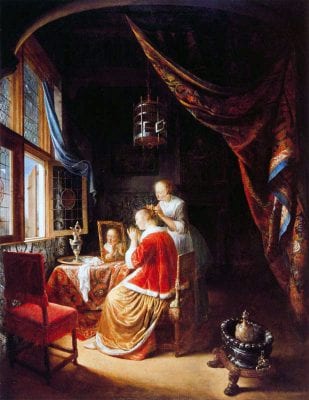
Significantly, documents reveal that several hinged panels shuttered paintings of domestic scenes. Such interior pictures with household views include, for example, Gerrit Dou’s96 The Wine Cellar, ca. 1660,97and Lady at Her Toilet, 1667 (fig. 15),98 as well as Johannes Vermeer’s Woman Holding a Balance, ca. 1664.99 I argue that the specific scenarios depicted in such enclosed paintings of domestic interiors provide precisely the type of fertile subjects worthy of the curiosity and engagement of the viewer as neighbor.
In Dou’s Wine Cellar, for example, a young man and a maidservant in the foreground of an intimate candle-lit interior catch each other’s flirtatious and furtive attention. The subject has been identified as young love with its attendant pitfalls signaled by various admonitory details.100 Always mindful of official neighborhood strictures to uphold individual and communal honor, the viewer as neighbor might judge the young lovers’ behavior. Alternatively, the viewer may remind him/herself of the ever-present potential for gossip; self-congratulate his/her own abstention from such youthful indiscretion; be amused by such human frailty; delight voyeuristically in such titillating behavior, and so on.
In Dou’s Lady at Her Toilet, an elegantly dressed young woman accompanied by her maid preens before a mirror in her well-appointed room and invites a possible judgment about the perils of vanitas by the viewer as neighbor (fig. 15). The scene also implies an imminent seduction. The young woman sits beneath an empty birdcage with an open door, which conventionally symbolizes a loss of virginity.101 She may await a male visitor, who would assume the empty seat (left) and enjoy the cooled wine (right).102 Lady at Her Toilet engages the curiosity of the viewer in any number of ways that are akin to the experience of peering through an actual domestic window with an open shutter.
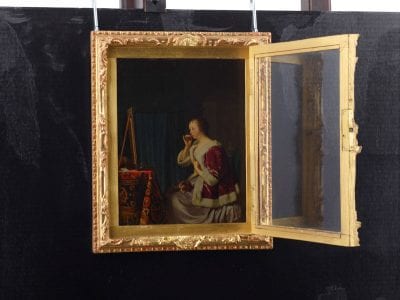
By the mid-eighteenth century, hinged glazed panels, which closely resemble transparent windows, protected numerous mid-seventeenth-century Dutch domestic scenes depicted in fijnschilderijen in the collection of Augustus III, elector of Saxony and king of Poland. Such paintings include Young Woman at Her Dressing Table, 1667, by Frans van Mieris, the Elder (fig. 16). The hinged windows with small locks and keys were attached to one of the vertical edges of the paintings’ frames. They superseded (or augmented) the earlier mid-seventeenth-century Dutch use of protective, hinged wooden shutters. I suggest that the hinged, glazed panels also invite inquisitive looking, as if from a neighborhood street into a domestic interior.

A pair of transparent mullioned windows, hinged to the vertical edges of a finely crafted Dutch dollhouse, ca. 1686-ca. 1710, attest further to the popularity of such visual and physical interplay, which engaged the window motif (fig. 17). The miniature house appealed to the adult tastes of its wealthy owner Petronella Oortman. Such dollhouses for elite women testified to their socioeconomic status. They also provided ritual play that reinforced deeply embedded cultural norms about the domestic roles of virtuous wives and mothers.103 The windows of Petronella Oortman’s dollhouse close over and protect the interior rooms, which are furnished with exquisite miniatures of furniture, household goods, and figures. Yet when closed, the transparent windows also ensure a view into the dollhouse.104 Together, the three variations of protective hinged panels—wooden shutters over mid-seventeenth-century Dutch paintings; windows over Augustus’s seventeenth-century Dutch fijnschilderijen; and mullioned windows over an ornate late seventeenth-century Dutch dollhouse—attest to the long-lived evocation of a neighbor’s viewing experience through a street-side window into an actual domestic interior.
Over time, the full range of changes to The Goldfinch, which Wadum’s restoration revealed, suggest that Fabritius explored additional contexts for the painting’s display, which might also have included or referenced a window setting. For example, at an intermediary stage, as we have seen, the white plaster background of the painting extended completely to the right edge of the panel, but the original black border remained visible on the top, left, and bottom edges.105 The artist may have intended for the panel to have a frame or other device attached to only the top, left, and bottom edges for some now unknown purpose. Regardless of whether Fabritius displayed The Goldfinch in additional ways, the illusionistic painting of the little bird within a plaster window jamb found its inspiration in pictorial convention, contemporary social practice, and the significant role of the window in neighborhood social exchange.
